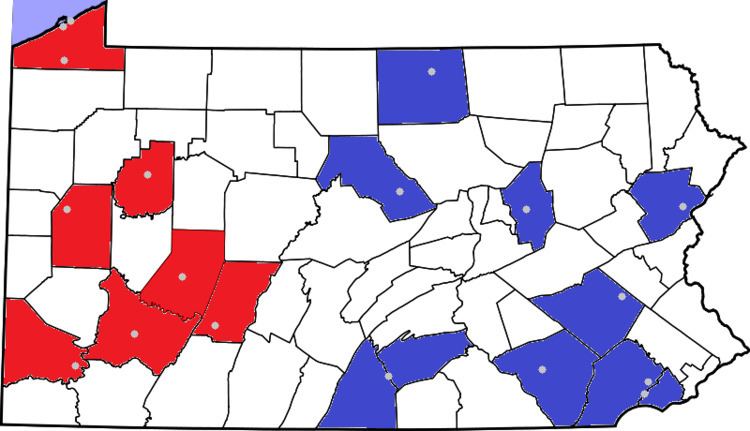Established 1951 (1951) | Association NCAA Members 18 full members | |
 | ||
Sports fielded 23 (men's: 11; women's: 12) | ||
The Pennsylvania State Athletic Conference (PSAC) is a collegiate athletic conference that participates in the National Collegiate Athletic Association (NCAA) Division II level. The conference is currently composed of 18 full-time members within Pennsylvania. The conference headquarters are located in Lock Haven, Pennsylvania and staffed by a commissioner, two assistant commissioners, and a director of media relations.
Contents
History
The Pennsylvania State System of Higher Education organized the conference in 1951 to promote competition in men's sports amongst the system's 14 universities. In 1977, following growing interest, the conference was expanded to offer competition in women's sports. From its inception, each conference member selected its own competitive division within the NCAA (I, II, or III). In 1980, however, the presidents voted to reclassify the entire conference to Division II within the NCAA.
Membership remained unchanged until the conference announced on June 18, 2007, that it had invited three private universities — Gannon University and Mercyhurst College in Erie, Pennsylvania and C.W. Post of Brookville, New York — to join the conference. Gannon and Mercyhurst left the Great Lakes Intercollegiate Athletic Conference to join the PSAC, effective July 1, 2008. C.W. Post became an associate member for football and field hockey.
In 2010, Seton Hill University was accepted to join the conference as an associate member for field hockey. With the additional transition of West Chester's program from Division I to Division II, the number of teams competing in field hockey increased from 10 to 12 for the 2011 season.
On August 19, 2012, the PSAC announced that Seton Hill and the University of Pittsburgh at Johnstown, formerly members of the West Virginia Intercollegiate Athletic Conference (WVIAC), would become full members beginning with the 2013–14 school year. This announcement was fallout from a split in the WVIAC that ultimately led to the formation of the Mountain East Conference (MEC). Although Seton Hill was one of the schools that initially broke away from the WVIAC, it chose not to join the MEC. The arrival of these two schools brought the PSAC to 18 full members, making it the largest NCAA all-sports conference in terms of membership.
Role in Division I conference realignment
The PSAC played a little-known but nonetheless significant role in the history of NCAA Division I conference realignment. In 1986, the conference was seeking a way out of a football scheduling conundrum. The PSAC had 14 members at the time, and had been split into divisions for decades. One of the methods it historically used to determine a football champion involved a championship game between the winners of its two divisions. However, due to NCAA limits on regular-season games, every PSAC team had to leave a schedule spot open, with only the two division winners getting to play all of their allowed regular-season games. Then-conference commissioner Tod Eberle asked Dick Yoder, then athletic director at West Chester and member of the Division II council, to draft NCAA legislation that would allow the PSAC to play a conference title game that would be exempt from regular-season limits. The initial draft required that a qualifying league have 14 members and play a round-robin schedule within each division; only the PSAC then qualified.
Before Yoder formally introduced the proposal, he was approached by the Central Intercollegiate Athletic Association, which was interested in co-sponsoring the legislation because it was also split into football divisions and wanted the option of a championship game. Since the CIAA then had 12 members, Yoder changed the legislation to require 12 members instead of 14. Although at the time all NCAA legislation had to be approved by the entire membership, regardless of divisional alignment, the proposal passed with little notice. It was generally seen as a non-issue by Division I-A (now FBS) schools since no conference in that group then had more than 10 members. While the PSAC planned to stage its first exempt title game in 1988, it decided against doing so at that time because the D-II playoffs expanded from 8 to 16 teams that season, and it feared that the result of a title game could cost the league a playoff berth. The new NCAA rule would not see its first use until the Southeastern Conference took advantage of it by expanding to 12 members in 1991 and launching a title game the following year. In 2014, Sports Illustrated writer Andy Staples said that the rule "helped dictate the terms of conference realignment for more than 20 years."
Current members
Membership timeline
Full member (all sports) Full member (non-football) Associate member (football-only) Associate member (sport)
Sports
In wrestling; Bloomsburg, Clarion, Edinboro, and Lock Haven compete as members of the Division I Eastern Wrestling League. The PSAC holds an annual championship open to all Division I and Division II teams. The PSAC offers championships in the following sports.
Women's sponsored sports by school
Other sponsored sports by school
Notable alumni
The following is a list of alumni of the respective universities, including before the formation of the Conference in 1951.
